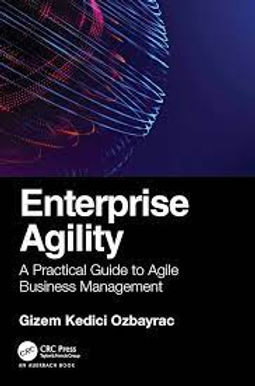Executive Board Member @Roche Turkiye
Chief Officer of Business, Digital, Data, Transformation
Academic Publishing
Enterprise Agility:
A Practical Guide to Business Management
Taylor & Francis Publishing, UK


Despite the astonishing technological developments in our times, it is surprising how little has changed in the way organizations are structured and managed. However, organizations are finally changing as they embark on agile transformations.
Agility concepts emerged from the dynamics of project management and have evolved as they are being applied to organizational structure and operations. This phase of the agile evolution is known as enterprise agility.
Filled with real-world scenarios and company case studies, Enterprise Agility: A Practical Guide to Agile Business Management covers the evolution of agility, including applied processes, lessons learned and realized outcomes. The book starts with the initial phase of the agile evolution, project agility and describes how waterfall project management is transformed into scrum, which can have positive effects on project timelines, scope and budget, as well as team motivation. The second phase of agility, organizational agility, is the evolution of the agile principles from temporary projects to permanent organizational structures. The book explains the main components of organizational agility, including structures, roles and ways of organizing work. It emphasizes the advantages of transitioning from traditional organizational management to agile. Finally, the latest phase, enterprise agility, transforms each function of the organization. The book acts as a guide and describes the change through the lens of each managerial domain (sales, marketing, HR, finance etc.) and by presenting the positive impact generated on the company’s overall performance based on case studies.
The last chapter illustrates the enablers of this transformation and how they can help the change to be internalized so that the enterprises realize improvements.
The book is based on the author’s over 15 years of experience of supporting more than 25 companies in varied sectors on their transformational journey, with the last 5 years concentrating on agility. By combining business management trends and principles of agile business development, it shows managers how to lead the transformation to enterprise agility by following the path from project agility to full enterprise agility.
Seminar Lectures
New Ways of Business Management
Seminar Class
Management Institute


Learning Objectives:
-
During this seminar, students have a chance to understand how the business management practices have started to shift completely with the agile way of management.,
-
The seminar aims students to understand how each function of an enterprise, independent of the industry operates with agility.
Format:
-
The seminar agenda includes first explanation of theoretical concepts of project, organizational and finally enterprise agility, then share case study examples and end each session with an interactive evaluation.
-
For the interactive sessions, the students will act like members of the relevant business function (HR, marketing, finance etc) and discuss the before and after agility dynamics to business.